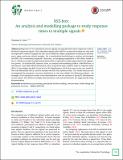Files in this item
RSE-box : an analysis and modelling package to study response times to multiple signals
Item metadata
| dc.contributor.author | Otto, Thomas U. | |
| dc.date.accessioned | 2019-09-11T14:30:04Z | |
| dc.date.available | 2019-09-11T14:30:04Z | |
| dc.date.issued | 2019-09-11 | |
| dc.identifier | 258895040 | |
| dc.identifier | 0bbc5849-e9df-42ed-ad1b-abe9617e947f | |
| dc.identifier | 000485770300004 | |
| dc.identifier.citation | Otto , T U 2019 , ' RSE-box : an analysis and modelling package to study response times to multiple signals ' , The Quantitative Methods for Psychology , vol. 15 , no. 2 , pp. 112-133 . https://doi.org/10.20982/tqmp.15.2.p112 | en |
| dc.identifier.issn | 2292-1354 | |
| dc.identifier.other | ORCID: /0000-0002-8621-9462/work/61622248 | |
| dc.identifier.uri | https://hdl.handle.net/10023/18463 | |
| dc.description | This work was supported by the Biotechnology and Biological Sciences Research Council (BBSRC, grant number: BB/N010108/1). | en |
| dc.description.abstract | Responses to two redundant sensory signals are typically faster than responses to the individual component signals. This redundant signals effect (RSE) is extensively studied not only with an impressive variety of signals but also across different subject populations focusing on development, aging, and many clinical samples. Yet, a standardized methodology to analyse and interpret the RSE is not consistently employed. Moreover, an intriguing explanation of the effect, based on the so-called race model championed by Raab (1962), is typically not fully appreciated in its explanatory power. To facilitate RSE research, here, an analysis and modelling toolbox, called RSE-box, is introduced. It provides MATLAB functions that (1) perform basic analysis steps on response times (RTs), (2) investigate the RSE at the level of RT distributions, (3) fit the most recent race model by Otto and Mamassian (2012), and (4) simulate the RSE with synthetic data. The model functions are accompanied by parameter recovery simulations to test and validate the fitting procedures. An example of the simulation results is the demonstration that the analysis of group RT distributions can be biased. The RSE-box includes demonstration code and all functions are supported by help-documentation. | |
| dc.format.extent | 22 | |
| dc.format.extent | 1099431 | |
| dc.language.iso | eng | |
| dc.relation.ispartof | The Quantitative Methods for Psychology | en |
| dc.subject | Multisensory processing | en |
| dc.subject | Perceptual decision making | en |
| dc.subject | Reaction time | en |
| dc.subject | MATLAB toolbox | en |
| dc.subject | Model fitting and parameter recovery | en |
| dc.subject | BF Psychology | en |
| dc.subject | RC0321 Neuroscience. Biological psychiatry. Neuropsychiatry | en |
| dc.subject | QA Mathematics | en |
| dc.subject | DAS | en |
| dc.subject.lcc | BF | en |
| dc.subject.lcc | RC0321 | en |
| dc.subject.lcc | QA | en |
| dc.title | RSE-box : an analysis and modelling package to study response times to multiple signals | en |
| dc.type | Journal article | en |
| dc.contributor.sponsor | BBSRC | en |
| dc.contributor.institution | University of St Andrews. School of Psychology and Neuroscience | en |
| dc.identifier.doi | 10.20982/tqmp.15.2.p112 | |
| dc.description.status | Peer reviewed | en |
| dc.date.embargoedUntil | 2019-09-11 | |
| dc.identifier.url | http://github.com/tomotto/RSE-box/ | en |
| dc.identifier.grantnumber | BB/N010108/1 | en |
This item appears in the following Collection(s)
Items in the St Andrews Research Repository are protected by copyright, with all rights reserved, unless otherwise indicated.

